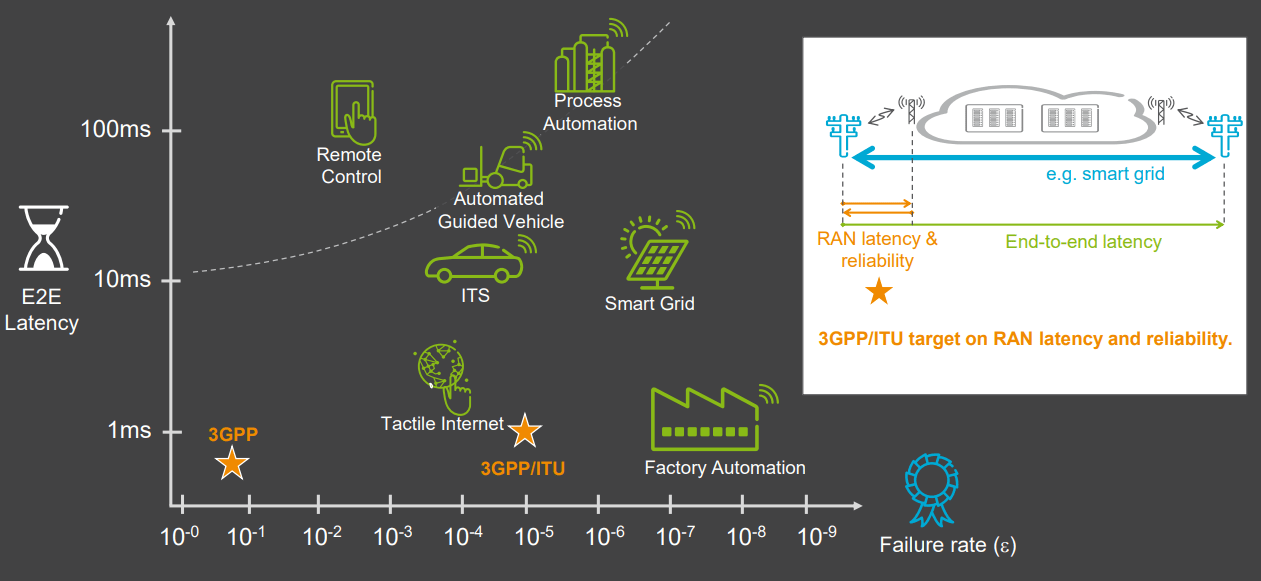Introduction
Typical usage scenarios for 5G include enhanced Mobile BroadBand (eMBB), massive Machine Type Communications (mMTC), which realizes large numbers of simultaneous connections, and Ultra-Reliable and Low-Latency Communications (URLLC).
Actually, what makes 5G totally different is its capability to support vertical use cases that require ultra-reliable low latency communications (URLLC). Such mission-critical use cases can be found in industrial automation, real-time control, augmented reality/virtual reality (AR/VR)-based applications, as well as consumer-oriented services such as gaming.
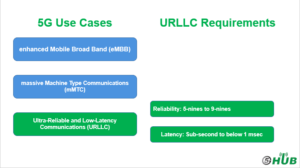
5G Use Cases
To a large extent, the industry has a good understanding of eMBB and mMTC use cases, technically and businesswise. URLLC use cases are new that differentiate 5G from earlier generations of mobile communication systems, although a lot of studies and proof of concepts projects have been carried out to understand where URLLC is needed and what are the requirements on communications systems, how 5G can be the best solution to meet those requirements.
To facilitate the technical specification in standard organizations and support operator business development, as well as to foster the eco-system, a holistic view of URLLC use cases and their requirements on 5G is needed.
Overview of URLLC
The goal of ultra-reliable and low-latency communication (URLLC) lies in satisfying the stringent reliability and latency requirements of the mission and safety-critical applications. Achieving this is equivalent to characterizing statistics of extreme and rare events (e.g., taming the tail of latency distribution), in contrast to the average based system design.
To meet this requirement, 3GPP has been using an approach centered on system-level simulations to meet the 99.999% (5-nine) reliability and 1 ms latency targets, using some techniques like (short packet transmission, grant-free mechanisms, leveraging spatial, frequency, and temporal diversity techniques).
URLLC Building Blocks
URLLC can be broken down into three major building blocks, namely: risk, tail, and scale.
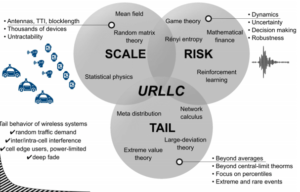
URLLC Building Blocks
Risk: risk is coming across when dealing with decision making under uncertainty when channels are time-varying and in the appearance of network dynamics.
Tail: the idea of tail behavior in wireless systems is related to the tail of random traffic demand, tail of latency distribution, intra/inter-cell interference, and users that are at the cell edge, power-limited, or in the deep fade. Therefore, extreme value theory mathematical finance and network results are important methodologies.
Scale: this is motivated by the total amount of devices, antennas, sensors, and other nodes that cause serious challenges in terms of resource allocation and network design.
URLLC Use Cases
URLLC is targeted mainly for services such as traffic control or remote control, which require both high reliability and low latency. The following use cases are typical examples.
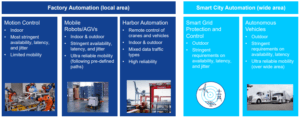
URLLC Use Cases (Source: Nokia)
- Control of Autonomous Vehicles and Traffic Control
This use case involves sending warning signals between vehicles and other vehicles, roadways, and even pedestrians to reduce traffic accidents, improve traffic efficiency, and support movement of emergency vehicles.
- Robot Control and 3D Connection with Drones and Other Devices
Automation of manufacturing and logistics using robots at smart factories and other facilities is anticipated, and control of these is a use case for 5G. It is also expected to cover airborne as well as terrestrial applications, so the ability to control drones and other devices in the air remotely is also specified.
- Remote Surgery
Remote can be implemented using optical communications or other fixed networks, but this is difficult to apply in disaster areas or other dangerous situations. Remote surgery in such locations is another use case for 5G.
- Monitoring or surveillance
One or more endpoint devices transmit sensory information to the other endpoint device as necessary in order for the other endpoint device to deduce the health of a tool, product, or system. Systems diagnostic solutions may “close-the-loop” around the diagnostic information to implement control capabilities such as equipment shutdown or continuous process improvement.
All of the above use cases require high reliability and low latency, and in most cases, the wireless systems are to be used for sending the control signals. For these cases, there are strict
requirements on 5G URLLC regarding reliability, low latency, and mobility rather than high transmission speed or large numbers of connected terminals.
URLLC REQUIREMENTS
Performance requirements for low-latency and high-reliability scenarios
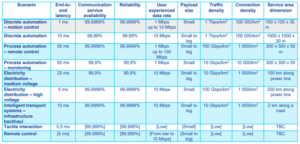
URLLC Requirements (ITU)
The definition of latency and reliability as below:
End-to-end (E2E) latency: E2E latency includes the over-the-air transmission delay, queuing delay, processing/computing delay and retransmissions when needed. Ensuring a round-trip latency of 1 ms and owing to the speed of light constraints (300 km/ms), the maximum distance at which a receiver can be located is approximately 150 km. Regarding 3GPP, there are two definitions for the latency User plane and control plane.
The minimum requirements for user plane latency are 4 ms for eMBB and 1 ms for URLLC assuming a single user and the minimum requirement for control plane latency is 20 ms.
Reliability: capability of transmitting a given amount of traffic within a predetermined time duration with high success probability. The minimum requirement for reliability is 1−10−5 success probability of transmitting a layer 2 protocol data unit of 32 bytes within 1 ms.
Cloud robotics enabled by 5G latency requirements as an example
The main motivation with the advancement of industrial robotics for manufacturing factories is to enable product customization and further optimization of the production lines to remain competitive in an innovation-driven economy.
Reducing the cabling and centralization of control nodes will reduce infrastructure costs and will provide higher flexibility, which are the main traits of the factories of the future. 5G networks and cloud computing can support such a transition with minimal impact.

Cloud robotics enabled by 5G latency requirements (Source: Ericsson)
Industrial robotic cells have a local computer, a Programmable Logic Controller (PLC), that costs money, takes space, and creates heat that requires cooling. Individual, isolated robot controllers also have limitations on coordination. Moving control into a cloud environment allows the footprint of the robot to be reduced, facilitating a higher density production. It also allows reducing the robot cost as a control computer is not required for each robot.
To achieve this goal, robots shall be connected with their controllers via high bandwidth, low latency, and reliable wireless communication networks. An on-site cloud computing environment is realized alongside with the legacy system.
Control functions (e.g. AGV coordination functions, line PLC, station PLC) which control the overall automation cell (including robots and conveyor belts) are placed on such a local cloud platform, which is connected with sensors and actuators (on AGV, Valves, I/O modules, on the robot).
Reference
- Ultra-Reliable and Low-Latency Wireless Communication, IEEE.
- Beyond 5G wireless IRT for industry 4.0: Design principles and spectrum aspects,”
- Ultra-Reliable Low Latency Communication for 5G New Radio, Nokia.
- Overview of URLLC, Ericsson
- 5G URLLC: Design Challenges and System Concepts.
- Verticals URLLC Use Cases and Requirements by NGMN Alliance.

